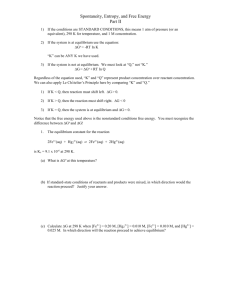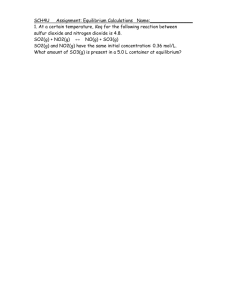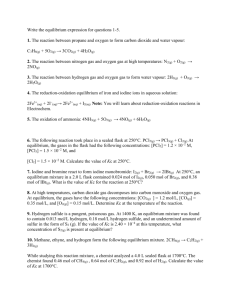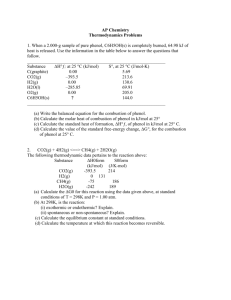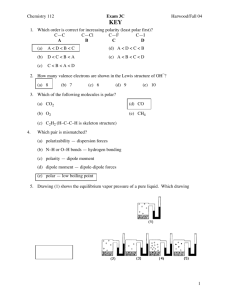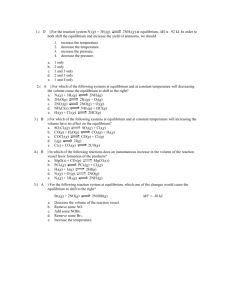Exam 3B - Key - UIC Department of Chemistry
advertisement
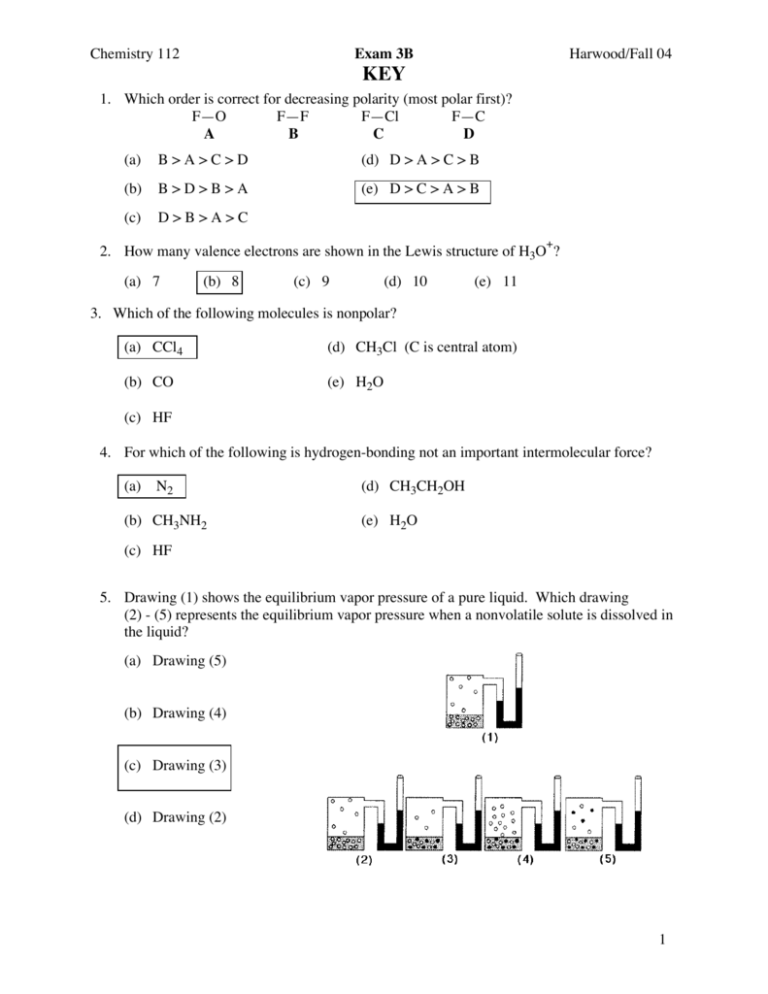
Chemistry 112 Exam 3B Harwood/Fall 04 KEY 1. Which order is correct for decreasing polarity (most polar first)? F—O F—F F—Cl F—C A B C D (a) B>A>C>D (d) D > A > C > B (b) B>D>B>A (e) D > C > A > B (c) D>B>A>C + 2. How many valence electrons are shown in the Lewis structure of H3O ? (a) 7 (b) 8 (c) 9 (d) 10 (e) 11 3. Which of the following molecules is nonpolar? (a) CCl4 (d) CH3Cl (C is central atom) (b) CO (e) H2O (c) HF 4. For which of the following is hydrogen-bonding not an important intermolecular force? (a) N2 (b) CH3NH2 (d) CH3CH2OH (e) H2O (c) HF 5. Drawing (1) shows the equilibrium vapor pressure of a pure liquid. Which drawing (2) - (5) represents the equilibrium vapor pressure when a nonvolatile solute is dissolved in the liquid? (a) Drawing (5) (b) Drawing (4) (c) Drawing (3) (d) Drawing (2) 1 Chemistry 112 Exam 3B Harwood/Fall 04 KEY 6. The following pictures represent the equilibrium state for four different reactions of the type A2 + X2 ↔ 2 AX (X = B, C, D, E). A atoms are open circles. X atoms are closed circles. Which reaction has the largest equilibrium constant? (a) A2 + E2 ↔ 2 AE (b) A2 + D2 ↔ 2 AD (c) A2 + C2 ↔ 2 AC (d) A2 + B2 ↔ 2 AB 7. A2 + B2 ↔ 2 AB A2 + C2 ↔ 2 AC A2 + D2 ↔ 2 AD A2 + E2 ↔ 2 AE The abundance of silver in seawater is 0.0003 mg/L. What is the concentration in parts per million (ppm)? # 0.0003 " 10–3 g & 6 –4 (a) 3 % ( " 10 = 3 " 10 1000 g $ ' (b) 0.3 –2 (c) 3 × 10 –3 (d) 3 × 10 ! –4 (e) 3 × 10 8. Which of the following solutions has the highest boiling point? (a) 0.1 m urea Molality of particles 0.10 (b) 0.06 m HCl in water 0.12 (c) 0.05 m CaCl2 in water 0.15 (d) 0.04 (NH4)3PO4 in water 0.16 (e) 0.07 m NaCl in water 0.14 highest b.p. is sol’n with the largest molality of particles 9. For the gaseous system, 2 H2S(g) + 3 O2(g) ↔ 2 H2O(g) + 2 SO2(g) how is KP related to KC at a given temperature? (a) unrelated to Δn (b) greater than KP = KC (RT) Δn = 4-5 = –1 (c) equal to so KP < KC (d) less than 2 Chemistry 112 Exam 3B Harwood/Fall 04 KEY 10. A mixture is prepared with [CO] = 0.035 M, [Cl2] = 0.015 M and [COCl2] = 0.75 M. It is 3 known that KC for the equilibrium CO(g) + Cl2(g) ↔ COCl2(g) is 1.2 × 10 at 400°C. Predict what will happen. (a) The reaction occurs in the forward direction. (b) The reaction occurs in the reverse direction. (c) The reaction is at equilibrium so no net reaction occurs. 11. Q = 0.75 ( 0.035)(0.015) Q = 1.4 " 103 Q>K (d) It is impossible to predict without more information. ! For the system NH4HS(s) ↔ NH3(g) + H2S(g), the equilibrium constant expression is (a) [NH4HS] / [NH3] [H2S] (c) [NH3] [H2S] (b) 1 / [NH3] [H2S] (d) [NH3] [H2S] / [NH4HS] 12. Consider the following exothermic reaction: N2(g) + 3 H2(g) ↔ 2 NH3(g) Which of the following changes would not increase the amount of NH3 produced from Increasing P (or decreasing V) will given quantities of N2 and H2? cause shift toward less moles of gas (a) an increase in P (right). Increasing T will cause shift to left. (b) an increase in T Removing product will cause shift toward right. (c) a decrease in V (d) removing some NH3 and reestablishing equilibrium (e) none of the above 13. Consider the reaction 2 SO3(g) ↔ 2 SO2(g) + O2(g) ΔH° = +198 kJ All of the following changes would shift the equilibrium to the left except one. Which one would not cause the equilibrium to shift to the left? (a) Add some SO3. (b) Decrease the container volume. (c) Add some SO2. (d) Decrease the temperature. Adding reactant will cause shift to right. Decreasing V will increase P causing shift toward smaller number of moles of gas (left). Adding product will cause shift to left. Decreasing T will cause shift to left (endothermic). END OF SCANTRON PORTION OF EXAM 3 Chemistry 112 Exam 3B Harwood/Fall 04 KEY 14. (a) What is the shape (molecular geometry) of CO2? (Circle one and show work.) tetrahedral linear bent (b) Is SO2 polar or nonpolar? (Show work) •• •• •• •• 4 pts O=C=O •• • • •• •• 4 pts •• O– S = O Polar •• ! (c) List all intermolecular forces present in a sample of CO2? 4 pts ! Dispersion –1 each incorrect 15. Consider the following endothermic reaction: PCl5(g) ↔ PCl3(g) + Cl2(g) (a) At a certain temperature, the equilibrium mixture contains 1.5 atm PCl5, 0.10 atm PCl3 and 7.50 atm Cl2. What is the equilibrium constant, KP, for this reaction? KP = (P )(P ) (P ) PCl 3 Cl 2 PCl 5 = (0.10)(7.50) (1.5) 4 pts –1 sig figs –1 math error KP = 0.50 ! (b) If 1.00 mole of PCl3(g) and 1.00 mole of Cl2(g) are placed in a 5.00-L container, the above equilibrium is reached. What is the equilibrium concentration of PCl3 and Cl2? (KC = 10.0 at the reaction temperature for the above reaction) PCl5(g) ↔ PCl3(g) + Cl2(g) Initial 0 0.200 0.200 Change +x –x –x Equilibrium x 0.200 – x 0.200 – x 2 0.0400 – 0.400 x + x 2 x x 2 x – 10.400x + 0.0400 = 0 x = 10.396, 0.003848 10.0 = !P PCl3 (0.200 – x) 5 pts = –1 sig figs +3 set up = PCl2 = 0.200 – (0.003848) = 0.196 atm (c) Will an increase in temperature favor the decomposition of PCl5? 4 pts Yes (d) Will a decrease in volume favor the decomposition of PCl5? 4 pts No 4 Chemistry 112 Exam 3B Harwood/Fall 04 KEY BONUS QUESTION 16. Lysine, one of the amino acid building blocks found in proteins, contains 49.29% C, 9.65% H, 19.16% N, and 21.89% O by elemental analysis. A solution prepared by dissolving 30.0 mg of lysine in 1.200 g of the organic solvent biphenyl, gives a freezingpoint depression of 1.37°C. What is molecular formula of lysine? (Lysine does not dissociate.) (Kf for biphenyl is 8.00°C/m) 10 pts C: H: N: O: (49.29 g)(1 mol/12.011 g) = 4.104 mol ==> 3 (9.65 g)(1 mol/1.0079 g) = 9.5744 mol ==> 7 (19.16 g)(1 mol/14.0067 g) = 1.36792 mol ==> 1 (21.89 g)(1 mol/15.9994 g) = 1.36818 mol ==> 1 Empirical formula: C3H7NO +3 correct ratios and/or emp formula Molar mass = 73 g/mol ΔTf = Kfm 1.37°C = (8.00°C/m) m m = 0.17125 mol / kg +2 correct molality (1.200 × 10–3 kg)(0.17125 mol/ kg) = 2.055 × 10–4 mol Molar mass = (30.0 × 10–3 g) / (2.055 × 10–4 mol) = 146 g/mol +2 correct molar mass (146 g/mol)/(73 g/mol) = 2 Molecular formula = C6H14N2O2 Give partial or full credit if they work the problem differently from above but it makes sense what they have done. They don’t have to work the problem my way. 5


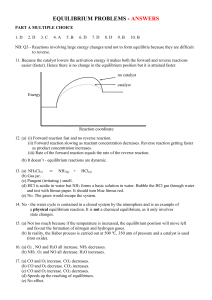
![CHEM 1520 SI MON, TUES, & WEDNES 1.Calculate [H3O+] in a](http://s3.studylib.net/store/data/007346334_1-b78d73402f58153c92290299886ff084-300x300.png)
